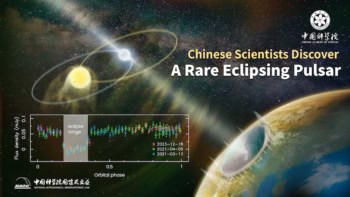
Two astronomers in the US have found a Type 1a supernova that did not leave behind a surviving companion star after it exploded. Instead, they conclude that the supernova was caused by two white-dwarf stars colliding and then both stars being consumed in the conflagration. Although the observation is of just a single supernova, the discovery adds weight to the theory that at least some Type 1a supernovae are the result of such collisions.
Type 1a supernovae are short-lived stellar explosions that are called “standard candles” because they all seem to give off the same amount of light. This means that astronomers can use these supernovae to measure distances in the universe – indeed, the accelerating expansion of the universe, which was the subject of last year’s Nobel Prize for Physics, was discovered using such supernovae.
Despite Type 1a supernovae being incredibly useful, astronomers are still in the dark about certain aspects of how these explosions occur. Most agree that the conflagration takes place when a white-dwarf star gains enough mass to become more than 1.4 times the mass of our Sun – the so-called Chandrasekhar limit. At this point, the inward force of gravity overcomes the outward pressure of the star, which collapses and then explodes.
What is not clear, however, is where that extra mass comes from. The question is important because, depending on its progenitor, a Type 1a supernova that happened billions of years ago might not necessarily have the same brightness as one occurring more recently. If standard candles are not really “standard”, it would cause a headache for astronomers.
Pair of white dwarfs?
For many years the favoured theory was that the white dwarf captures gas from a companion star until the explosion occurs. However, computer simulations revealed several problems with the physics of this scenario. This led to a rise in the popularity of another progenitor model – a pair of white dwarfs that orbit each other until they get close enough to collide and then explode.
An important difference between these two progenitors is that the two white dwarfs are expected to be consumed in the explosion, whereas a companion star should survive the supernova. As a result, astronomers have been studying the remnants of Type 1a supernovae to see if they can spot surviving companions. The problem, however, is that most remnants are either too far away or in crowded parts of the sky, making it very difficult to work out whether a companion exists or not.
Now, Bradley Schaefer and Ashley Pagnotta of Louisiana State University have found the perfect candidate for such a study. Using an image taken by the Hubble Space Telescope (HST), they analysed a remnant called SNR 0509-67.5 in the nearby Large Magellanic Cloud. Because some of the light from this supernova is still bouncing around space, astronomers know that it occurred about 400 years ago and that was a Type 1a.
400 years of travel
The remnant itself is a bubble of gas expanding outwards from where the explosion took place. The bubble is not perfectly spherical, so Schaefer and Pagnotta combined the results of several different methods to determine the location of the supernova. Next, the pair worked out the maximum distance that a companion could have moved in the 400 years since the explosion took place. They did this by considering all the possible types of companion and then working out the maximum velocities that these stars would have after the explosion. Schaefer and Pagnotta also considered the effect that the explosion might have on brightness of the companion star – by blowing off some of its mass.
With these parameters in mind, they then looked very carefully at the HST image to see if there was any evidence of a companion star within the distance and brightness limits they calculated. None was found, not even at brightness levels several orders of magnitude below that expected for the dimmest of companions. This absence of a companion led Schaefer and Pagnotta to conclude that this particular Type 1a supernova could only have proceeded from the collision of two white dwarfs.
Describing the certainty of the result, Schaefer told physicsworld.com that “There is no wriggle room – this is a decisive result.” While the observation suggests that two white dwarfs could indeed be the progenitor of some Type 1a supernovae, it does not entirely rule out companions other than white dwarfs. Indeed, Rubina Kotak of Queen’s University Belfast in Northern Ireland believes that while the latest work provides important information about the origins of Type 1a supernovae, there are probably a number of progenitor systems in nature.
Unfortunately, given that ideal systems such as supernova remnant SNR 0509-67.5 are expected to be few and far between, it is likely that the debate will continue to be informed by computer simulations rather than observations.
The study is described in Nature.



